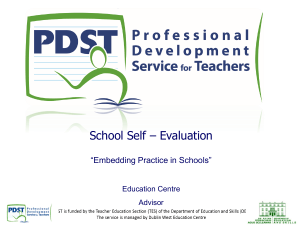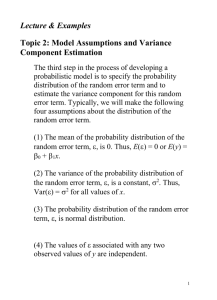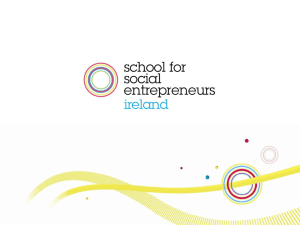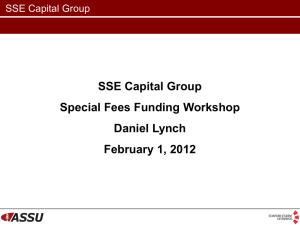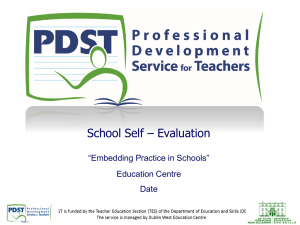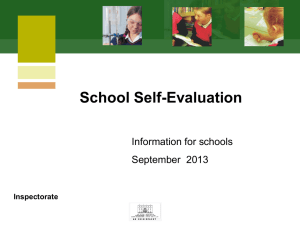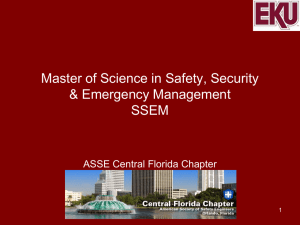School Self-Evaluation Inspectorate Presentation
advertisement
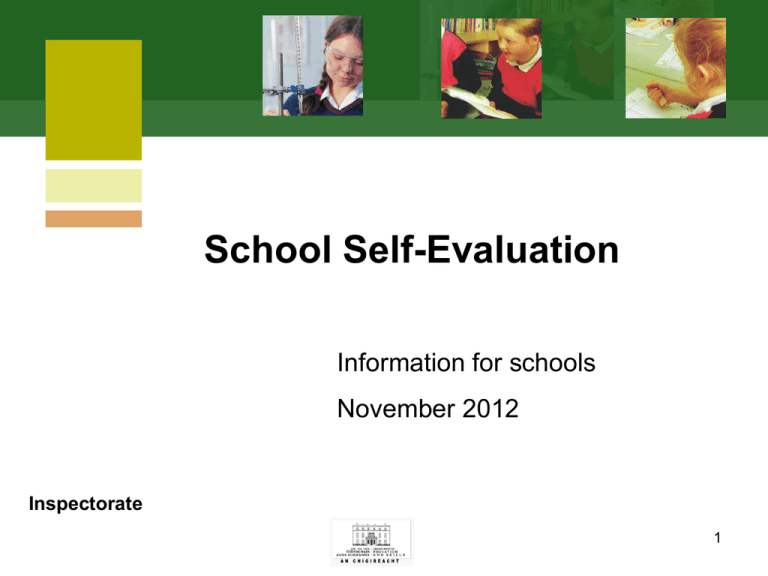
School Self-Evaluation Information for schools November 2012 Inspectorate 1 Aim of session – To enhance understanding of SSE – To prepare schools to use SSE as a school improvement process 2 Objectives of Session 1. What is SSE? 2. Why? 3. What does the SSE process look like? 4. What does this mean for schools? What does this mean for me as a teacher? 5. Support for SSE 3 1.WHAT IS SCHOOL SELFEVALUATION? 4 What is school self-evaluation? • SSE is a way of systematically looking at how we teach and how our students learn and making decisions about what we want to improve Because • We want to make learning better for students • We want to make teaching more rewarding • Schools are best placed to examine their own practice and to tell their own story 5 Put another way… SSE is a process that allows schools and teachers to improve outcomes for learners. • • • • • • Reflect Collaborate Gather evidence Arrive at decisions about quality (Judgement) Direct school improvement Improve learning 6 2. WHY SCHOOL SELF-EVALUATION? 7 Why school selfevaluation? We know SSE works – Research here: • evidence from DEIS schools • pilot project trial schools – Research in other countries • New Zealand, Scotland, Finland, Canada 8 Why school selfevaluation? • Part of balanced and integrated approach to supporting better teaching and learning • Supports the Literacy and Numeracy strategy • Consistent with DEIS (Delivering Equality of Opportunity in Schools) (action planning) • Gives greater autonomy to teachers 9 SSE encompasses… Over time schools will address three dimensions – Teaching and Learning – Management and leadership – Support for pupils We want schools to start by focusing on teaching and learning 10 We are focusing on teaching and learning… Because… – Teaching and learning is the core work of school – All teachers want to improve learning for students Building on and reframing SDP – SDP helped focus on developing policy, promoted collaboration and dialogue – SSE will focus more on having an impact on teaching, learning and outcomes for students 11 SDP and School Self-Evaluation The SSE process is a reframing of the school development planning process It places a greater focus on gathering evidence and making judgements It works best when it is integrated into the dayto-day work of the school It leads to action for improvement 12 Task Purpose of task: • To give teachers an opportunity to reflect on what is currently working well in teaching and learning in their school and how they know this • To highlight the need to base judgements on evidence Task • In pairs discuss what is working well in teaching and learning • Indicate how you know • Suggest how you could find out more 13 3. WHAT DOES THE SCHOOL SELFEVALUATION PROCESS LOOK LIKE? 14 Frequently used terms in SSE – Learner outcomes – Evidence – Evaluation criteria – Quality statement – Continuum 15 SSE Process Getting started • Start small – a limited aspect of teaching and learning • In first four years: literacy, numeracy and one other area • Ask simple questions – – – – – How well are we doing? How do we know? What evidence do we have? How can we find out more? What are our strengths/areas for development? How can we improve? • Build on what you know…. 16 Sub-themes Theme SSE framework: Teaching and Learning 17 18 19 SSE PROCESS Sources of evidence • Assessment data – formative and summative • Group/subject department reflection • Whole-school reflection • Learner and parent surveys (student/parent voice) • Peer dialogue/sharing • Focus group discussion • Team planning and teaching • Interviews • Professional collaborative • Individual teacher reflection experience review DON’T COLLECT TOO MUCH INFORMATION! 20 SSE PROCESS Analysing data and benchmarking against evaluation criteria • Check learner motivation, attitudes, engagement in learning, application of knowledge and skills • Share and compare practice – think and reflect on this • Examine attainment levels of students (standardised tests/SEC data) : check against national norms, for in-school trends • Use evaluation criteria to check analysed data against a set of standards 21 SSE PROCESS Reflect and draw conclusions • Reflect on the information you have • Reflect on how this compares to best practice • Do the criteria and quality statement help to identify next steps in improvement? • Can you place practice in this area of work on a continuum from significant strengths to significant weaknesses? 22 SSE PROCESS SSE is not about paper work. However schools need to write a concise report • Report (no more than 2/3 pages) should record - Theme chosen for self-evaluation - Brief account of school context - The findings - Summary of strengths (affirm and celebrate) - Summary of areas requiring improvement - Legislative and regulatory requirements checklist (for BOM) 23 SSE PROCESS Our School Improvement Plan Summary of main strengths as identified in last SSE: Summary of main areas requiring improvement as identified in last SSE: Improvement Targets Required actions Persons responsible Timeframe for action Success criteria/measurable outcomes Review date(s) 24 SSE PROCESS Agreed actions for improvement must be implemented • Actions to be implemented at individual teacher, class, subject department or whole-school level must be monitored • Schools will need to decide • Who will be responsible for monitoring? • How monitoring will occur? • How progress will be determined and reported? • When progress will be reported (structures – staff/department meetings) • If targets and actions are realistic or need to be changed • What changes are necessary? 25 Task Purpose of task • to introduce sample tools from the Guidelines and to reflect on how you might use these to gather evidence in your own school Task • Use the sample self-reflection tool for teachers to think about a recent lesson. Share your reflection with a colleague. and/or • How would you use the sample open questionnaire for students? 26 4. WHAT DOES THIS MEAN FOR SCHOOLS AND TEACHERS? 27 Starting the SSE process Circular 0040/2012 • Over a four year period engage in SSE of literacy, numeracy or one other aspect of teaching and learning – Take one of these aspects each year – A whole-school approach to SSE to be taken with a focus on teaching and learning – All teachers engage in SSE of the aspect selected by the school – Produce a short SSE report and summary for school community – Devise school improvement plan with targets to improve outcomes for students and summary for school community – Implement and monitor School Improvement Plan over three-year period 28 DEIS schools are ahead .. • DEIS schools are already setting targets and have improvement plans in place for attendance, retention, progression, literacy, numeracy, student attainment and partnership • DEIS schools should ensure that their reviews of practice are based on good SSE processes, including having an SSE report • The DEIS action plan is your school improvement plan 29 As a school.. For example in school X they have • Selected literacy • Examined records of students’ progress and assessment to check current achievement • Decided on strengths in relation to literacy • Identified what needed to improve • Agreed that they need to focus on teaching approaches in order to improve literacy 30 As a teacher.. In school X my responsibility as a teacher is to: • Reflect on my own teaching approaches • Discuss teaching approaches with subject department/ colleagues • Reflect on whether I need further evidence? Views of students? Others ? • Look at the evaluation criteria for teaching approaches • Identify strengths and areas for development • Agree teaching approaches that could be used to further develop students’ literacy skills at a subject department level 31 Evaluation Criteria Approaches •Teaching approaches support students in engaging with the literacy and numeracy demands of the subject •Subject-appropriate teaching and learning methodologies with a focus on active learning are used •Lessons are well structured •A range of subject-appropriate approaches is used including –Guided discussion –Collaborative and cooperative learning –Investigative approaches –Higher order thinking and problem solving –Encouragement of the students' personal and creative response to the subject 32 Quality Statement Teaching is focused, stimulating and relevant to the students’ learning needs. ………… Effective subject-specific learning approaches are used. Opportunities for the development of literacy and numeracy skills are well used. Subject-specific language is thoroughly taught. Lessons are well developed in a way that allows for progression of students’ skills, knowledge and attitudes. All aspects of the subject are thoroughly taught with progression apparent in the students’ learning as they move from one year to the next. A broad range of activities is provided to enhance the holistic development of the student. 33 As teaching staff.. Whole staff responsibility • Subject departments share experience and results of reflection with whole staff • Ensure evidence is balanced • Agree further sources of evidence, if not balanced – Agree what tools will be used and whose views should be garnered – Agree who will gather, collate, analyse and feedback • Ensure that findings from all evidence gathered and analysed helps draw conclusions/make judgement • Write report • Devise school improvement plan • Implement and monitor across all subject departments 34 SSE report – school X Focus Literacy selected (L and N strategy, STEN results for first-year) Context Co-ed school of 700 students. It offers the JC, TY, LCE, LCA, LCVP. Its enrolment has remained static. Findings Focused on literacy: identified weaknesses in oral work Identified need to change our approaches to teaching literacy across subject departments Strengths A large proportion of students performed well in reading tests A strong staff commitment to promotion of literacy Majority of students interested in reading Areas for improvement Oral skills of first-year students 35 School improvement plan Target At present X% of students demonstrate competence in oral language using school developed test. By Dec 2015, X+10% will demonstrate competence in oral language using the school developed test. Actions Increased emphasis on oral work in lessons •Use of key terminology, role play, structured group work, focused discussion on topics Development of listening skills •Video/audio listening task with accompanying worksheets Responsible All teachers Timeframe Three years for overall target Every term for monitoring Success criteria Ongoing greater student engagement and confidence and competence in using subject specific terminology …. Overall: A measurable proportion of students will demonstrate greater oral competence in teacher administered oral tasks Review dates Ongoing: end of each term/year Overall: Dec 2015 36 As teaching staff.. Strategies agreed in the School Improvement Plan • • • • Implemented over a three-year period Embed in classroom practice Part of day-to-day work Progress monitored 37 5. SUPPORTS FOR SCHOOL SELFEVALUATION 38 SSE Support Support for SSE • Publications • Website www.schoolself-evaluation.ie • PDST seminars for principal • Internal collaboration – use experience and expertise in own school • Professional networks 39 AND A FINAL WORD…. 40 Key messages – School self-evaluation works – Start small and keep it simple – Involve all teachers – Include the voice of students (and parents where relevant) – Only gather relevant information – Agree strategies and actions for improvement – Implement and monitor – Celebrate success SSE as part of normal and ongoing practice in the school 41 Thank you Go raibh maith agaibh www.education.ie 42
